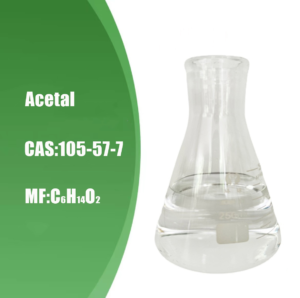Acetal (chemical name: diethoxymethane, abbreviated as acetal). In the past ten years, in the fine chemical industry, as an excellent organic solvent, it has been widely used commercially, and its preparation method, separation, purification and application research have attracted widespread attention from all over the world.
The nature of the molecular structure of acetal determines that it has particularly good chemical stability, thus determining that it has a wide range of application values in chemical processes. Practice has proved that acetal is stable in many strong bases (such as metal hydroxides), NaH, Grignard reagents and organolithium reagents, but it will be very stable in aqueous acid solutions. Experiments have shown that the decomposition rate of acetal is only ≤1% after mixing 24 hours in an equal volume of acid and aqueous solution (pH=2) at room temperature. This stability is conferred by the inherent hydrophobicity of acetal, which limits its exposure to proton sources. Therefore, acetal can still be used stably in medium strong acid aqueous solution (pH>4). Although acetal is also an ether compound, its tendency to form peroxides in an oxidizing atmosphere is much lower than that of other ethers (such as tetrahydrofuran, etc.) Rarely converted to peroxide). It has low mutual solubility with water, which is beneficial to product purification, and the economy of the process will be better. It can be seen from the molecular constituent groups of acetal that acetal can be used as a chemical reaction reagent, such as ethoxymethylation reagent, methyleneation reagent and carbonylation reaction substrate. Acetal can also be used as a substitute for formaldehyde and ethanol under anhydrous acidic conditions.
Applications:
- Acetal as a solvent
The chemical stability and low viscosity of acetal determine that it can be used as a solvent with good performance in various chemical processes such as extraction, dilution and recrystallization. Since acetal is immiscible with water, when it is used as a solvent medium in chemical processing, less waste liquid and waste water are generated during recycling, which improves the environmental protection advantages and economical efficiency of the processing process. Since acetal has a freezing point as low as -66°C and a boiling point as high as 88°C, its operating temperature range is suitable for many chemical processes. Therefore, acetal is a potential new generation of industrial organic solvents, which may replace the existing tetrahydrofuran (THF), ethyl acetate, methylene chloride, toluene, 1,4-dioxane, methyl tertiary Organic solvents such as butyl ether, ethylene oxide and other ethers . Acetal is used as an industrial organic solvent. It has the characteristics of wide application range, non-toxic safety and easy operation.
- New energy additives
Acetal is a very useful solvent in anhydrous lithium batteries and anhydrous aluminum batteries. Compared with other ether solvents, it is found that acetal has little change in battery voltage, can inhibit the decomposition of electrodes and electrolytes, and can make the battery Recharge more times.
Researchers from FMC Corporation of the United States heated NaAlH and LiCl together in an acetal solvent from 25 °C to the boiling reflux temperature of acetal until the reaction was complete. LiAlH products can be directly produced through metathesis in one step171. Japanese scholars have developed a low-pollution methanol-based automotive fuel. This fuel consists of three types of components:
(1) Methanol;
(2) heavy gasoline, and the weight ratio of (1)/(2)=2~5;
(3) Two or more additives (including acetal, diethoxyethane and MTBE, etc.).
- Processing aids for resins and coatings
Acetal is a good solvent for formulating phenolic resin adhesives, urea resin adhesives and neoprene adhesives. This type of adhesive has low viscosity, strong penetration, good brushing performance, stable storage and longer effective service life. In addition, acetal can be used in coating additives commonly used in automotive coatings. In peroxyethylene paint thinner, acetal can replace toxic benzene thinner.
Acetal is used as an end-capping agent in the production of polyoxymethylene resins, which can not only improve the thermal stability of polyoxymethylene copolymers, but also increase the yield of resin products. For example, researchers from Ticona Company in Germany dissolved 0.2X 10 West (according to the weight of trioxane monomer used) trifluoromethanesulfonic acid in 500×10-6 acetal, and added it to 96. In a mixed monomer composed of 6% trioxane and 3.4%–oxolane, polymerize at 80°C to obtain a copolymerized acetal resin. Such polymer molecules contain very few unsaturated end groups.
- As formaldehyde equivalent
Acetal is a protected form of formaldehyde that can be used as a substitute for anhydrous formaldehyde, making the reaction safer. For example, acetal, like CH20, can be used as a methylene reagent. One-step Synthesis of Dihydroisoflavone Derivatives Using Acetal as Reagent.


